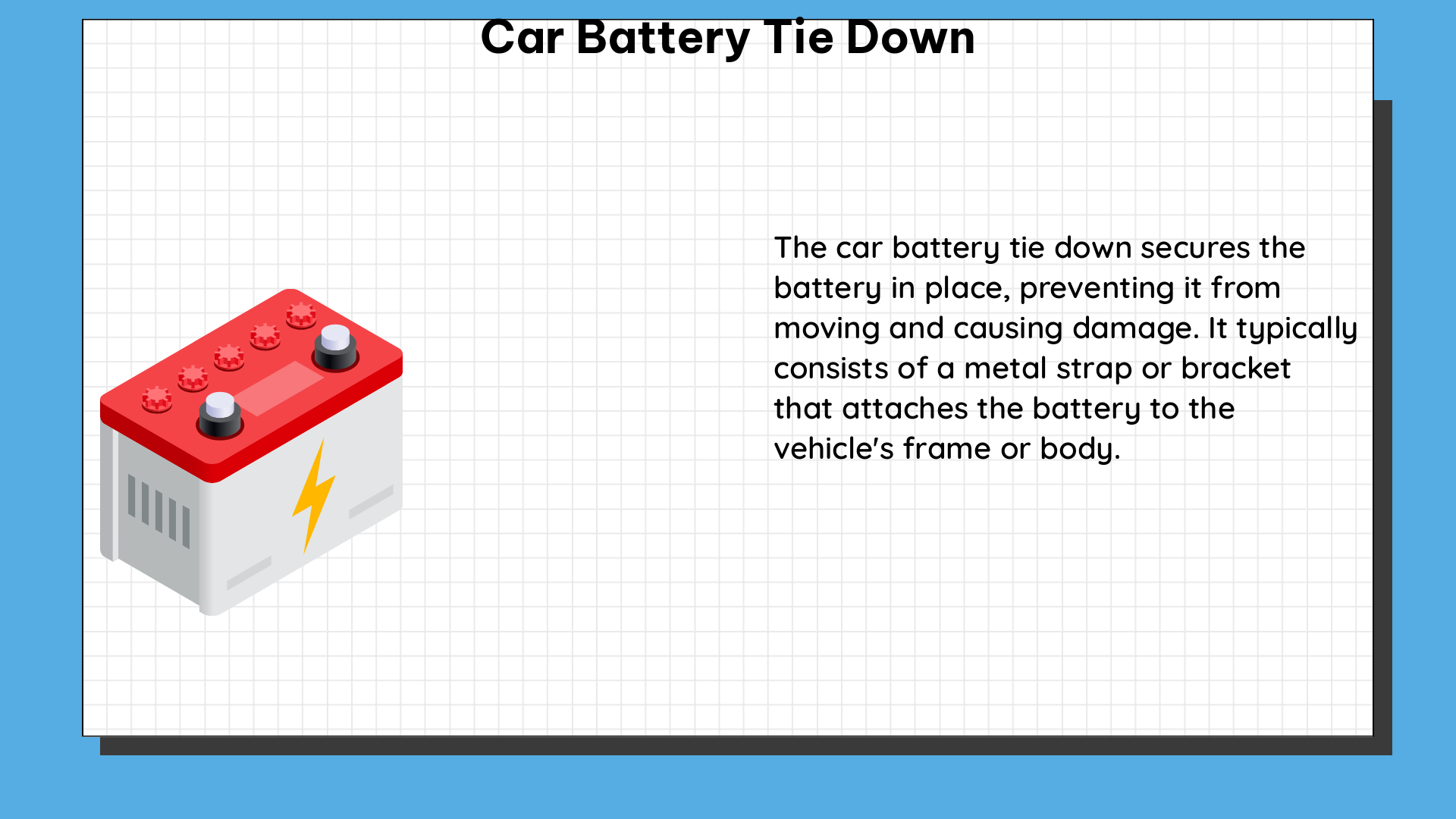A car’s battery is a crucial component that powers the entire electrical system, and its proper placement and securement are essential for the vehicle’s safe and efficient operation. The car battery tie down is a critical element in maintaining the battery’s position and preventing it from shifting or becoming dislodged during operation. This comprehensive guide will delve into the technical specifications, installation considerations, and measurable data points to help you ensure your car’s battery is securely and reliably held in place.
Understanding the Importance of a Proper Car Battery Tie Down
The car battery tie down serves several vital functions:
- Safety: A loose or improperly secured battery can become a significant safety hazard, as it can shift during sudden stops or turns, potentially causing damage to the battery itself or other components in the engine bay.
- Vibration Resistance: The tie down mechanism must be able to withstand the constant vibrations and shocks experienced by the vehicle, preventing the battery from becoming dislodged or damaged over time.
- Electrical Connectivity: A secure tie down ensures that the battery’s terminals remain in proper contact with the vehicle’s electrical system, maintaining a reliable power supply.
- Battery Longevity: By preventing excessive movement and vibration, a well-designed tie down can help extend the lifespan of the battery by reducing the risk of internal damage.
Technical Specifications for a Car Battery Tie Down

When selecting or designing a car battery tie down, it’s essential to consider the following technical specifications:
Material Composition
The tie down mechanism should be constructed from durable, corrosion-resistant materials that can withstand the harsh environmental conditions found in the engine bay. Common materials used include:
– Stainless steel
– Galvanized steel
– Aluminum alloys
Dimensional Requirements
The tie down must be sized to accommodate the specific dimensions of the battery being secured. Key measurements to consider include:
– Battery length, width, and height
– Clearance between the battery and surrounding components
Clamping Force
The tie down should be capable of exerting a clamping force that is equal to or greater than the weight of the battery, ensuring a secure and stable hold. This force can be calculated using the following formula:
Clamping Force (N) = Battery Weight (kg) x 9.8 (m/s²)
Vibration Resistance
The tie down must be able to withstand the vibrations and shocks experienced by the vehicle, preventing the battery from becoming dislodged or damaged. This can be evaluated through testing and measurement of the tie down’s natural frequency and damping characteristics.
Adjustability
The tie down mechanism should be designed with adjustability in mind, allowing it to accommodate different battery sizes and shapes, as well as changes in battery position over time due to vehicle modifications or component replacements.
DIY Car Battery Tie Down Solutions
For those looking to create a custom car battery tie down solution, there are several components that can be sourced and assembled:
Frame
The frame provides the structural foundation for the tie down and can be fabricated from materials such as:
– Steel angle iron
– Aluminum extrusions
– Stainless steel bars
Clamping Mechanism
The clamping mechanism secures the battery in place and can be designed using:
– Threaded rods and nuts
– Adjustable clamps or brackets
– Rubber or neoprene pads for cushioning
Mounting Hardware
The tie down must be securely mounted to the vehicle’s battery tray or other suitable attachment points. Suitable hardware includes:
– Bolts
– Washers
– Lock nuts
Measurable Data Points for Car Battery Tie Down Effectiveness
To ensure the car battery tie down is performing as intended, it’s essential to consider the following measurable data points:
Battery Weight
The weight of the battery is a critical factor in determining the required clamping force and the overall design of the tie down mechanism.
Vibration Levels
Measuring the vibration levels experienced by the battery during vehicle operation can help ensure the tie down is adequately resistant to the stresses it will encounter.
Clamping Force
Regularly checking the clamping force exerted by the tie down mechanism can help identify any loosening or degradation over time, allowing for timely adjustments or replacements.
Battery Terminal Voltage
Monitoring the battery terminal voltage can help detect any issues with the electrical connectivity maintained by the tie down, which could indicate a problem with the mechanism or the battery itself.
Environmental Conditions
Evaluating the tie down’s performance in various environmental conditions, such as temperature extremes, humidity, and exposure to corrosive elements, can help ensure its long-term durability and effectiveness.
By considering these technical specifications and measurable data points, you can ensure that your car’s battery is securely and reliably held in place, promoting safe and efficient vehicle operation.
References:
- Would my bungee cord qualify as a correct battery hold down?
- White powder forming on battery hold down bracket
- Will the battery be okay using this as a tie down?

The lambdageeks.com Core SME Team is a group of experienced subject matter experts from diverse scientific and technical fields including Physics, Chemistry, Technology,Electronics & Electrical Engineering, Automotive, Mechanical Engineering. Our team collaborates to create high-quality, well-researched articles on a wide range of science and technology topics for the lambdageeks.com website.
All Our Senior SME are having more than 7 Years of experience in the respective fields . They are either Working Industry Professionals or assocaited With different Universities. Refer Our Authors Page to get to know About our Core SMEs.